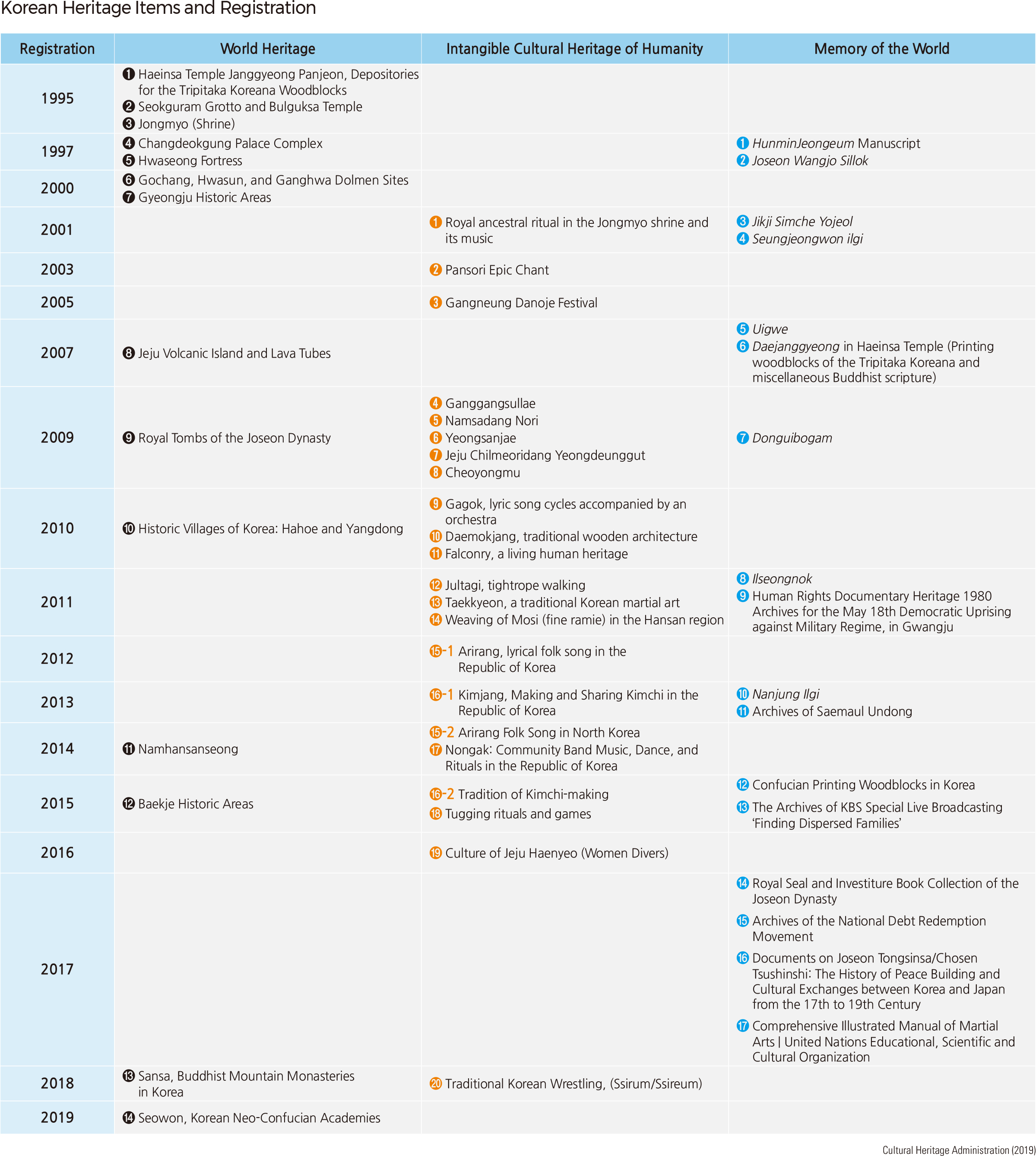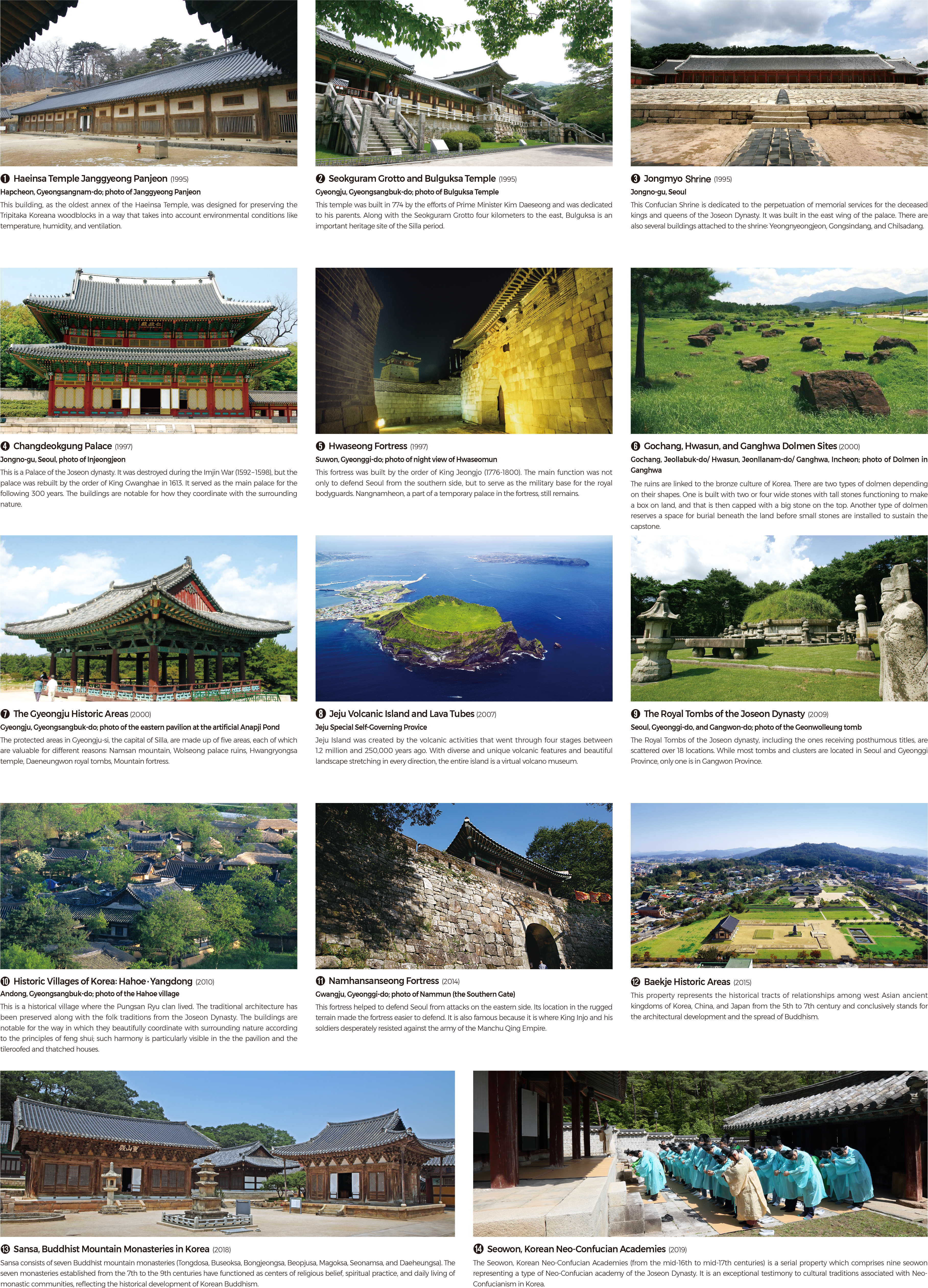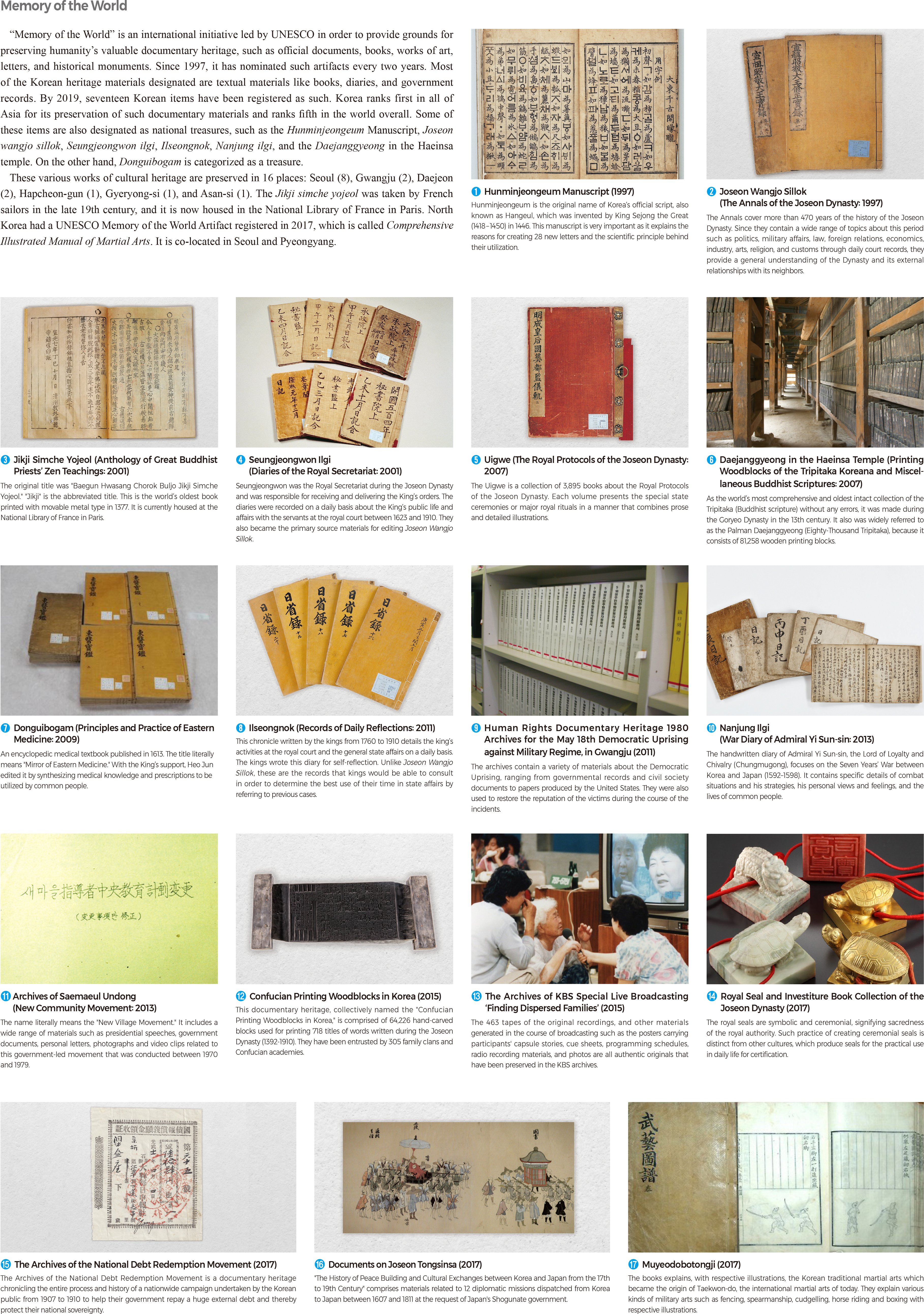English I 2019
The World Heritage Programme was created by UNESCO’s World Heritage Committee to identify, celebrate, and protect important universal, cultural, and natural sites for the benefit of all humankind. World Heritage Properties are divided into three classes: Cultural, Natural, and Mixed (both Cultural and Natural). A World Heritage site indicates a place where such valuable properties are located. Among the 16 Korean properties (including North Korea) inscribed by UNESCO, 15 are Cultural, and one is Natural.
The Korean World Heritage sites are mainly distributed in the central capital area (five sites) and Gyeongsangbuk-do (three sites). Because Seoul has functioned as Korea’s capital since the Joseon Dynasty, there are various historical sites such as palaces like the Changdeokgung Palace Complex, a Confucian Shrine (Jongmyo), and the royal tombs of the Dynasty. The military facilities located around Seoul also functioned as the capital’s defense, and chief among these is the Hwaseong Fortress and Namhansanseong Fortress. Gyeongju-si in Gyeongsangbuk-do is also noteworthy as an important historical spot. As the capital of an ancient kingdom, Silla, Gyeongju-si still possesses a variety of ancient relics, such as the Seokguram Grotto and Bulguksa Temple. In Gyeongsangbuk-do, historical villages date back to the Joseon Dynasty.
There are two heritage sites in North Korea (Historic Monuments and Sites in Gaeseong-si and the Complex of Goguryeo Tombs). Other provinces also have one cultural site each (Gyeongsangnam-do, Jeolla-do, and Incheon). Jeju Special Self-Governing Province’s volcanic nature has made it designated a World Natural Heritage Site called the “Jeju Volcanic Island and Lava Tubes.” It is divided into Hallasan Natural Reserve, Geomunoreum Lava Tube System, and Seongsan Ilchulbong Tuff Cone. Chungcheong-do and Jeolla-do have one culture site each (Baekje Historic Areas), and Gyeongsang-do, Jeolla-do, and Chungcheong-do have two culture sites each (Sansa, Buddhist Mountain Monastery in Korea, and Seowon, Korean Neo-Confucian Academy).
The heritage sites can also be categorized by their functions. There are various types of complex tombs such as the Gochang-gun, Hwasun-gun, and the Ganghwa Dolmen Sites of the Bronze Age, the Goguryeo Tombs of the Goguryeo Period, and the Royal Tombs of the Joseon Dynasty. The tombs reveal snapshots of the culture, the worldviews, and rituals of each period. Buildings on the list include Changdeokgung Palace, for instance, which blends with the surrounding nature. Designed to control temperature, humidity, and ventilation, Janggyeong Panjeon in Haeinsa Temple still contains the perfectly preserved Tripitaka Koreana woodblocks that have resided there for the past half-millennium. Gyeongju-si and Gaeseong-si, the former capitals of the Silla and Goryeo periods, have many historical monuments and sites. There are a variety of historical buildings, monuments, and ruins representing each age. Along with Ganghwa-gun and Gaeseong-si, which were designed as military bases to defend Seoul from the west and the north, two other fortresses, Namhansanseong Fortress and Hwaseong Fortress, are World Heritage sites. These played a critical role in defending the capital from the east and the south, and both are significant for historical and architectural reasons. The Korean folk villages of Hahoe and Yangdong, and Jongmyo, a royal shrine, are also noteworthy. Hahoe and Yangdong still observe the local Korean traditional customs. The latter shows the Confucian traditions of the royal family in the Joseon Dynasty with rituals, music, and dance. Sansa, the Buddhist Mountain Monasteries, shows clearly the historical importance of Korean Buddhism. Seowon is a kind of academy that taught Korean Neo-Confucian. Jeju Special Self-Governing Province, a volcanic island that has many distinctive lava tubes, is the only natural Korean heritage site.
In 2001, the Korean Intangible Cultural Heritage of Humanity was first inscribed in the list of UNESCO. By 2019, 20 types of intangible cultural heritages have been registered, particularly during the following three years: 2009, 2010, and 2011. Three types of activities that have been registered are rituals or rites (four cases), amusements (five cases), and songs (four cases). Among the other forms of protected cultural expression are Deamokjang, Taekkyeon, Hansan Mosi (Weaving of Mosi in Hansan), Kimjang (Making and Sharing Kimchi), Maesanyang (Falconry), and Culture of Jeju Haenyeo (Women Divers).
“Memory of the World” is an international initiative led by UNESCO in order to provide grounds for preserving humanity’s valuable documentary heritage, such as official documents, books, works of art, letters, and historical monuments. Since 1997, it has nominated such artifacts every two years. Most of the Korean heritage materials designated are textual materials like books, diaries, and government records. By 2019, seventeen Korean items have been registered as such. Korea ranks first in all of Asia for its preservation of such documentary materials and ranks fifth in the world overall. Some of these items are also designated as national treasures, such as the Hunminjeongeum Manuscript, Joseon wangjo sillok, Seungjeongwon ilgi, Ilseongnok, Nanjung ilgi, and the Daejanggyeong in the Haeinsa temple. On the other hand, Donguibogam is categorized as a treasure.
These various works of cultural heritage are preserved in 16 places: Seoul (8), Gwangju (2), Daejeon (2), Hapcheon-gun (1), Gyeryong-si (1), and Asan-si (1). The Jikji simche yojeol was taken by French sailors in the late 19th century, and it is now housed in the National Library of France in Paris. North Korea had a UNESCO Memory of the World Artifact registered in 2017, which is called Comprehensive Illustrated Manual of Martial Arts. It is co-located in Seoul and Pyeongyang. |



